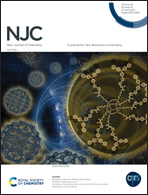Bi2O2CO3/TiO2 hybrid with 0D/1D nanostructure: design, synthesis and photocatalytic performance†
Abstract
Photocatalytic technology is a potential technology to meet energy and environmental requirements. Herein, the solvothermal method was used for the first time to synthesize a Bi2O2CO3/TiO2 hybrid with 0D/1D nanostructure, and the obtained materials were characterized systematically. In the architecture of the composite, Bi2O2CO3 quantum dots (QDs) (1.40–1.50 nm) uniformly grew on the surface of TiO2 nanobelts (NBs). The degradation efficiency of Rhodamine B under visible light irradiation was applied to evaluate the photocatalytic performance of the obtained materials. Of them, TB-3 exhibited the best photocatalytic performance, and more than 95.43% RhB was degraded under visible light. The reaction rate constant is 18.51 × 10−3 min−1, which is nine times larger than that of TiO2 NBs. Moreover, it exhibited remarkable stability and recyclability in a recycling experiment. According to the photoelectric characterization, the excellent performance may be attributed to the construction of a heterojunction and hybrid structure with 0D Bi2O2CO3 QDs and 1D TiO2 NBs, which endows the catalyst with faster migration of photo-generated carriers and less recombination of electron/hole pairs. Our work provides a promising method to build novel visible light-driven photocatalysts with a 0D/1D hybrid structure.



 Please wait while we load your content...
Please wait while we load your content...